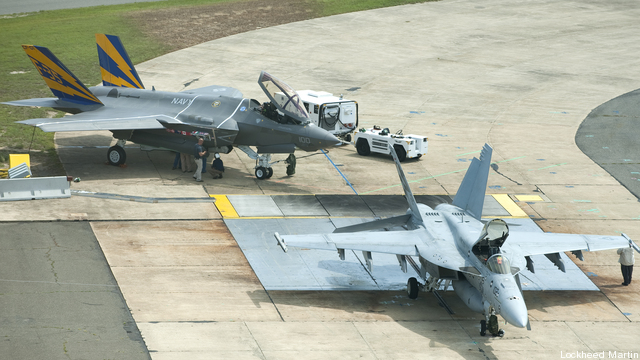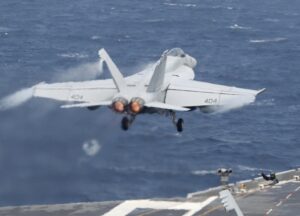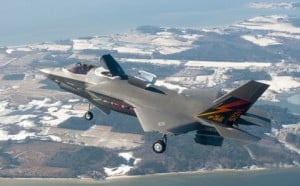
A Navy F-35C (upper left) and the plane it will replace, the F/A-18E Super Hornet (lower right), sit together on a runway.
President-Elect Trump’s recent announcement that he is considering acquiring the F/A-18 Super Hornet in place of the F-35 Lightning II does not add up for a leader who seeks “to make America great again.” Too much is at stake for the United States to rely on a fighter aircraft design whose roots extend back to the Nixon Administration. While the President-Elect’s concerns regarding the cost of weapons procurement is wholly valid, such decisions must be weighed in the context of current security demands.
Based on the tremendous cost and cost overruns of the Lockheed Martin F-35, I have asked Boeing to price-out a comparable F-18 Super Hornet!
— Donald J. Trump (@realDonaldTrump) December 22, 2016
Air supremacy, the mission fulfilled by the fighter planes, plays a pivotal role in warfare. Without control of the sky, no military operation can succeed. Planes like the F-35 represent the lynchpin on which ground power, sea power, and airpower can effectively engage. Want proof of this? Simply look at June 6, 1944, D-Day. By controlling the sky, the Allies were able launch a decisive invasion on the beaches of France that effectively sealed Nazi Germany’s fate. This effort would never have worked had the landing forces been subject to robust enemy air strikes or had Rommel’s panzer reinforcements been free to race to the beaches on road and rail networks undamaged by Allied air attack.

Navy F/A-18 Super Hornet
However, America’s ability to control the sky currently stands at risk. The majority of the fighter aircraft serving with the Air Force, Navy, and Marine Corps are 1960s and 1970s-era designs. Enemy nations have invested considerable sums in their defensive capabilities — better radars, better missiles, better computers, command, & control — which means that planes like the F/A-18 are likely to get shot down in a conflict. If Mr. Trump is concerned about saving money, the country should be investing in systems that can execute their missions and return home intact to fight another day. Buying decades-old designs is a recipe for disaster: aircraft shot down, pilots killed or captured, and objectives left unmet.
That is why Presidents on both sides of the aisle, Congress, and service leaders have pursued the F-35 for nearly two decades. Over those years, the program has made some costly stumbles — but no acquisition program is perfect, and the larger they are, the more problems they have. Nevertheless, today the F-35 is on track to provide a huge capability for a comparatively reasonable price: $85M by 2019. Decades-old designs like the F/A-18, F-15, and F-16 cost well within that range or more depending on what upgrades to the basic fighter are included.
It is also crucial to recognize that the F-35 doesn’t just do the same things better (though it does): It does things the legacy fighters just can’t do at all. First and foremost, planes like the F/A-18 will never be very stealthy because their designs were never built to evade radar, as evident in their shapes, construction materials, or avionics. Modernization cannot fix this problem: Stealth has to be built into a design from day one.

Marine F-35B in hover mode.
On top of this, the older aircraft were designed before the information age. One of the F-35’s most important attributes is its ability to collect, process, and disseminate information with assets across the battle arena. The positive effect of this is huge, like the difference between the brick-sized cell phones of the 1980s and a modern iPhone with many times the capabilities packed into much less space. Yes, they both can make calls, but the latter’s ability to provide key information anywhere, anytime has fundamentally enhanced the way in which we live our lives. Turning back the clock really is not an option.
Smart phones have also combined activities that used to require multiple independent systems: stereos, cameras, address books, calendars, desk top computers, GPS, and more. The same holds true for the F-35, because it does the job of multiple legacy planes. If Mr. Trump thinks the F-35 is expensive, he might want to consider the cost of buying and sustaining separate aircraft to execute the missions of air superiority and strike; close air support; vertical take-off and landing for the Marines and allies; intelligence, surveillance, and reconnaissance; cyber/electronic warfare; surface-to-air missile suppression; and more. There is no way this alternative is cheaper.
National security interests demand modern combat aircraft that are capable of executing their missions. The country also has a moral imperative to equip those in uniform with planes that will get them home safe. It’s a dangerous delusion to seek “savings” in buying decades-old designs that won’t even make it to the target.
Failing to build a modern, capable military invites our enemies to pursue aggressive action. It is no mistake that China is pushing the boundaries in the Pacific and Russia is destabilizing neighboring regions: They sense the US is weak and are taking advantage of the situation. We must redress these circumstances. Is it a good idea to try and get best value from a contract negotiation? Of course. However, it’s also crucial to buy capabilities that are capable of fighting effectively and winning. The F-35 is the only fighter currently in production in the United States that can do the job.
Doug Birkey is executive director of the Mitchell institute for Aerospace Studies, an affiliate of the Air Force Association.
China’s new H-20 stealth bomber ‘not really’ a concern for Pentagon, says intel official
“The thing with the H-20 is when you actually look at the system design, it’s probably nowhere near as good as US LO [low observable] platforms, particularly more advanced ones that we have coming down,” said a DoD intelligence official.


























